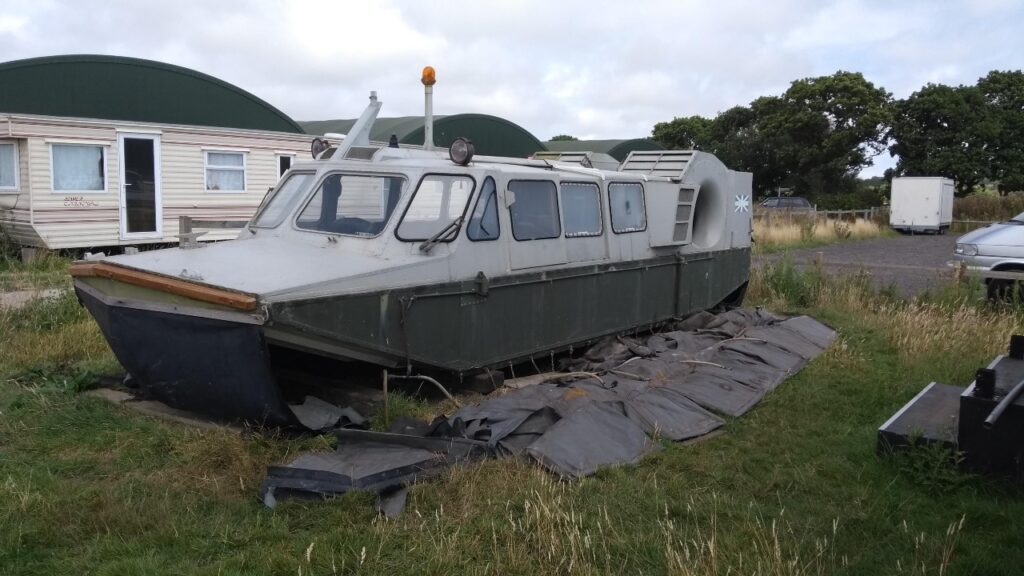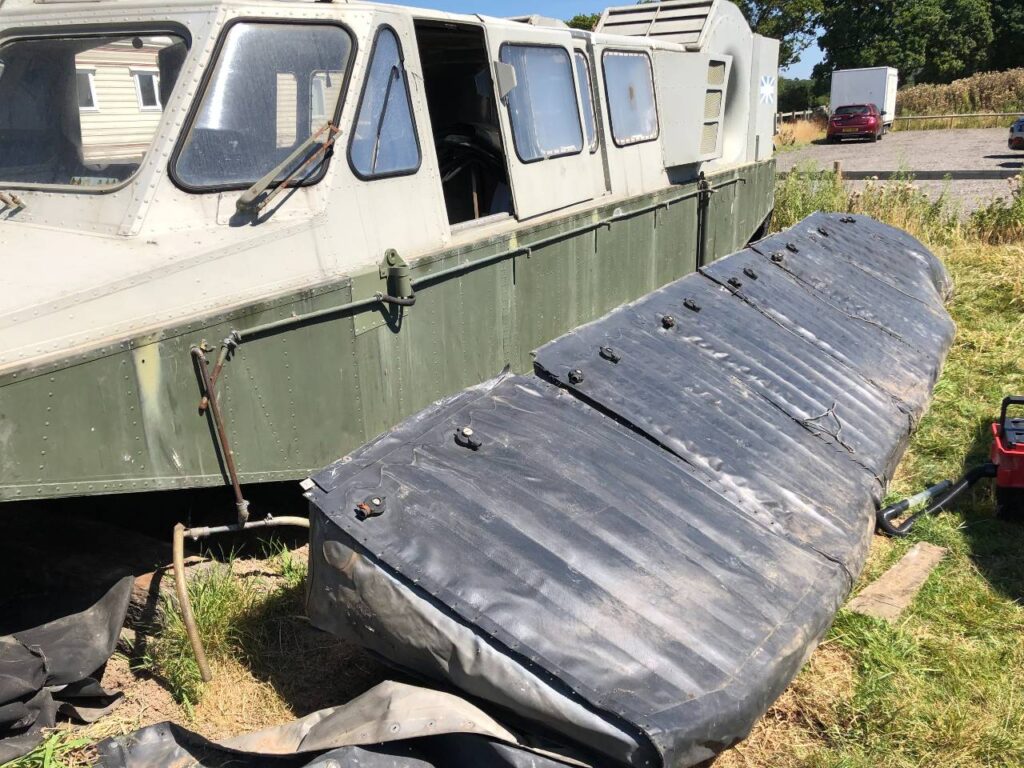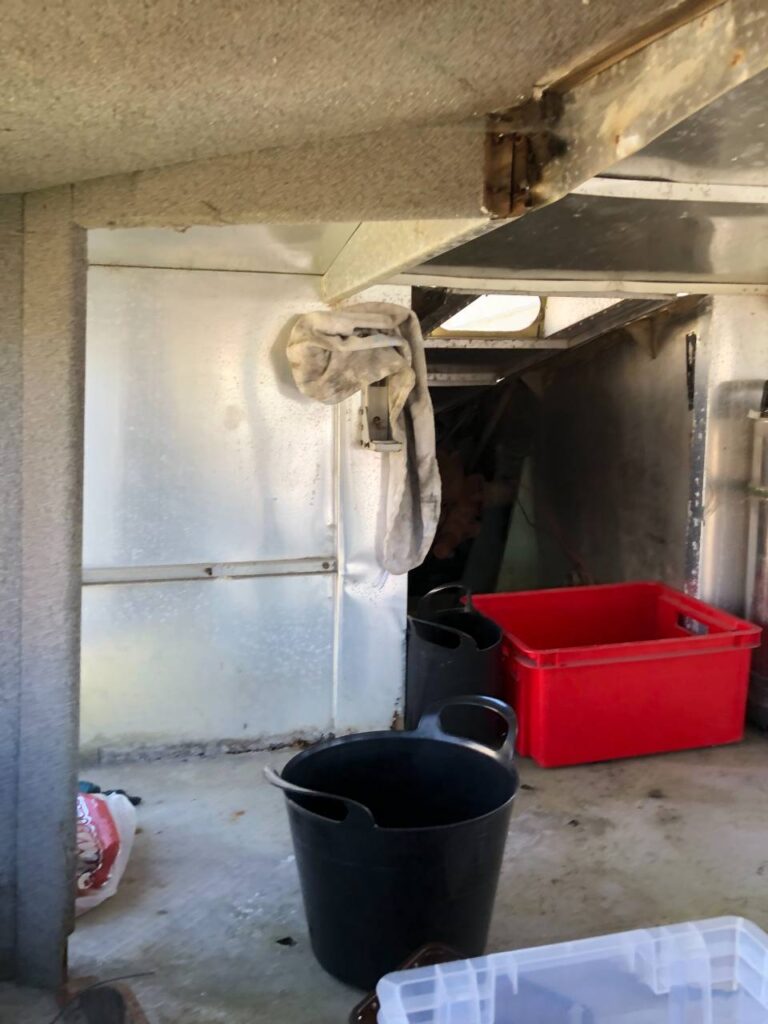Cushion-craft restoration progress report – Autumn 2022
Restoration Manager – Mark Porter
Introduction:
Restoration work on the hovercraft started afresh in early May 2022 following the end of Covid restrictions. The current phase of restoration has three main thrusts; to assess the craft’s condition, to prevent further deterioration, and to smarten up its appearance.
Restoration work is undertaken by the museum team members on Mondays and Wednesdays. Additional help and advice have been provided by the Britten-Norman Aircraft Preservation Society (BNAPS), including the donation of material and fasteners. A former Cushion-craft employee visited and provided helpful advice on the structure, seats and lifting the craft.
The technical manuals purchased from the Hovercraft Museum have been very useful.

General condition:
The craft’s condition is good considering its age. The basic metal structure is in generally good condition, with some corrosion at the aft end. Except for the aft cabin deck, the internal structure is in good condition, but some of the floor panels are missing or suffering water damage.
The craft is probably unique in having inflatable side decks. These are in fair condition considering their age.
The craft has been washed, and the water drain holes have been unblocked. The moss and mould have been scrubbed off.
Two display boards have been made for the craft and will be fitted behind the new side windows once they have all been fitted.
Craft surroundings:
The broken fence posts and rails were moved away from the craft and placed in line under the fence. This has allowed a strimmer to be used up to the edge of the craft, and the grass has been cut throughout the summer.
Removal of equipment:
Unnecessary and unrelated equipment has been removed from the hovercraft to facilitate working in the cabin. The Blackburn Turmo 600 engine and exhaust pipe have no relevance to the CC7 and were restricting work within the craft.
Mains wiring for museum lighting was removed from the starboard fan volute and the main cabin.
Basic structure:
When work started on the craft, very little of the structure could be seen as it was obscured by the inflatable side bags.
The port forward slinging and jacking point was missing and the surrounding area was damaged. The hull wall is breached in this location. This damage dates back to when the craft was at the Hovercraft Museum, or even before that. This area has been repaired by fabricating a new structural assembly and riveting it in place.
Superstructure:
The superstructure has been examined with a view to keeping the rain out. The door seals are poor but still provide adequate protection against light rainfall. Material has been obtained to make replacement seals, but as these are self-adhesive, they will not be fitted until the door surrounds have been painted. Over the winter the starboard door will be taped up as the entry via the port door will be sufficient in the short-term.
The lower structure at the starboard engine air intake was found to be damaged, preventing the intake from being locked in place. This was bent back into shape. As it is possible to obtain access to the craft via these intakes, they should be wire-locked in place to prevent casual access.
The roof structure aft of the cabin doors had been removed by the Army apprentices several years back and has not been refitted properly. The guttering has been straightened as well as possible, and the panels sealed with tape. An internal support frame is damaged. The two panels between the fan volutes have been located and laid in place to prevent water ingress. These panels were identified in the CC7 hovercraft manual as “exhaust extractor panel 2C10” and “rear panel 2C11”. They do not appear to have provision for fasteners to hold them in place, and it is presumed that these are not the original panels. These panels both had damage to their corners. They were taken into the workshop to be straightened and laid back in place on the craft to prevent water ingress.
The aft roof will need sheet metalwork, riveting, sealing, and painting next year. This part of the craft has been covered by a tarpaulin which will stay in place until the craft is moved.
Inflatable structure and skirts:
The craft has been progressively lifted along each side to allow the skirt and side body bags to be removed from where they were trapped under the craft. Work has continued to remove the inflatable structure from the craft. In order to separate each bag from the next to facilitate repairs, the skirt itself has been de-riveted from the bags. The lacing cord which held the side body bags in place has deteriorated and will need to be replaced.

Side body bags:
The side body bags are made from hovercraft skirt material, using similar materials and techniques. There are sixteen side bags, each has two valves, and these have all been found. Not all are working, and it has not been possible to identify these from their markings or by searching the Internet.
For each side body bag, an attempt was made to inflate it using a portable air pump. All but two inflated, but they do leak.
The forward starboard bag had a small rip on the inner face, which was repaired with a skirt rubber patch and contact adhesive. The forward port bag also had a large hole, evident in photos from when this craft was at the Hovercraft Museum. This hole has been repaired using pattern parts cut out from hovercraft skirt rubber and contact adhesive.
Spare fasteners for the upper edge of the side body bags have been obtained.
Skirt:
The outer skirt bag is in good enough condition for static display. The internal section of the bag has suffered damage but will not be visible when on static display.
The skirt fingers are in extremely poor condition. Much of the rubber coating has come off, and they are see-though in places. Skirt fingers will not be visible when on static display. We have some spare fingers in good condition, but not sufficient to complete the craft. We will put one of these on display next to the craft.
Interior:
There was an accumulation of water and debris in the bottom of the main cabin floor, and through into the torsion box. Some debris was removed by hand, and it was vacuumed out with a wet and dry vacuum cleaner. 30 gallons (140l) of water have been removed from the bottom of the main cabin floor, and through into the torsion box. Water continued to trickle through the joint between the starboard spine member and the frame at station 160.8 over a period of a few weeks. This has been allowed to settle and has been removed since.

Forward cabin:
The cabin interior has been swept, and detritus removed. Flaked paint has been removed from the forward cabin floor.
The two circular floor panels by the forward starboard seat have been refitted.
A replacement plate for the damaged area at the top of the forward port hull side wall has been made, painted and rivetted in place.

Aft cabin:
The raised portion at the back of the cabin is a structural torsion box. The top of this box has been cleaned and examined. The forward end of this top is made from plywood faced with aluminium. The plating was missing from this portion, and the wood had degraded, and vegetation was growing in the mulch. The area has been cleaned and dried, and water collection buckets have been used to minimise the amount of water accumulating in this area. The warm summer has largely dried this area, but repair work will need to be done here. The cabin rear wall was found to be severely corroded along the lower port edge and will need repair.
Seats and Trim:
The pilots’ seats are in good condition. Suitable fasteners were donated by BNAPS and both pilots’ seats have been secured in position.
The centre bench seat is in good condition and has been secured in position. The covering of the fixed seat in the starboard aft position in the cabin is ruptured and will need to be repaired.
The roof air vent punka louvres have been found and are stored inside the craft in one of the storage boxes donated by BNAPS.
Green mould has accumulated on the forward starboard cabin head lining. An attempt to brush this off produced an unacceptable amount of debris floating in the air. The interior trim panels at the port and starboard quarter light positions have been removed from the craft, washed and dried. They are currently stored off the craft. The wooden frame parts that supported the rear cabin trim have been removed from the craft. These have been cleaned and have been examined to determine how they go together and what repairs are needed.
Work has started on removing the roof centre trim panel, but many of the screws are rusted in place.
Engine Bay:
The mechanical fan drive components have been put in one large box inside the craft. Other components and panels have been put in a similar box. The fasteners which have been removed have been put in smaller boxes and labelled.
Doors and windows:
The door locking mechanisms on each side comprise three elements: an external locking handle, an internal lock bolt mechanism and an internal handle lever.
The external locking handles have been identified as Wilmot Breeden 1/13400 locking ‘T’ handle, similar those used in an Austin Mini. The locks have been dismantled as far as possible but are corroded solid. We do not have the keys for these locks. We will need to procure the external locking handles. The part numbers are, and these can still be obtained for around £80 for a pair including carriage.
The internal lock bolt mechanisms have been identified as Widney Hooklock 36081A and 36080A for port and starboard respectively. Replacements cannot be obtained. The old parts were very corroded but are being refurbished.
The internal handle levers were corroded onto the handle shaft, and will need to be replaced. These have been identified as Wilmot Breeden 1/5171 and will need to be replaced with a suitable equivalent.
Windows:
Perspex glazing for the craft sides have been kindly provided by Richardson’s Yacht Services. We have purchased new rubber seal material, which can be removed and reused when we paint the craft. Three windows have been replaced so far. The two quarter light panels were particularly difficult to fit and needed the purchase of the specialist tool. The first and second rectangular panels went in easily so the rest should be easy to fit.
Winter working:
The aft end of the craft has been covered with a tarpaulin to protect it from the elements. Holes and cracks are being covered with new tape that will stand up better to the weather. Access to the interior is still possible, so we can work on the doors, windows and craft interior and ensure no more water is entering the craft. Work will start on making the centre floor panel, based on the sister craft at the Hovercraft Museum. We have some aluminium alloy sheet which has been donated to us.
The aft cabin trim panels could also be rebuilt during the winter.
Craft Relocation in 2023:
The plan is to move the craft to a new display area of hard-standing in front of the museum and create a shelter structure to keep off the rain. This will be accessed by a new path creating easy wheel chair access for visitors to view the CC7.
You can support this restoration work by donating below:
If you would like to support our team of volunteers restoring the CC7 you can do so quickly and securely by donating via the link, many thanks.

